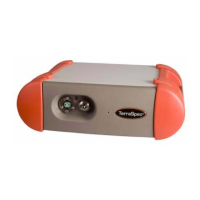ASD Document 600541 Rev. G 6 TerraSpec® User Manual
www.asdi.com Chapter 1 Introduction
1.4 Theory of Operation
The TerraSpec spectrometer measures the optical energy that is reflected by,
absorbed into, or transmitted through a sample. Optical energy refers to a
wavelength range that is greater than just the visible wavelengths, and is
sometimes called electromagnetic radiation or optical radiation.
With accessories, various set-ups, and built-in processing of the optical
energy signal, the TerraSpec spectrometer can measure:
• spectral reflectance,
• spectral transmittance, and
• spectral absorbance.
Fiber Optic Collection of Reflected/Transmitted Light
Optical energy is collected through a bundle of specially formulated optical
fibers, precisely cut, polished, and sealed for extremely efficient energy
collection. The fibers themselves are of low OH composition providing the
maximum transmission available across the instrument's wavelength range.
Inside the TerraSpec® Spectrometer
The fiber cable delivers the collected optical energy into the instrument,
where it is projected onto a holographic diffraction grating. The grating
separates and reflects the wavelength components for independent
measurement by the detectors.
Visible/Near-Infrared (VNIR)
The Visible/Near-Infrared (VNIR: 350-1000 nm wavelength) portion of the
spectrum is measured by a 512-channel silicon photodiode array overlaid with
an order separation filter. Each channel (or detector) is geometrically
positioned to receive light within a narrow (1.4 nm) range. The VNIR
spectrometer has a spectral resolution (full-width half maximum of a single
emission line) of approximately 3 nm at around 700 nm.
Each detector converts incident photons into electrons. This photocurrent is
continually converted to a voltage and is then periodically digitized by a
16-bit analog-to-digital (A/D) converter. This digitized spectral data is then
transmitted to the instrument controller for further processing and analysis by
the controlling software.
The 512-channel array permits the entire VNIR spectrum to be scanned in
parallel at 1.4 nm wavelength intervals. A single sample can be acquired in as
little as 17 ms.

